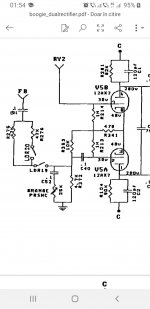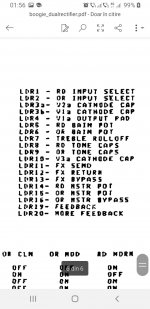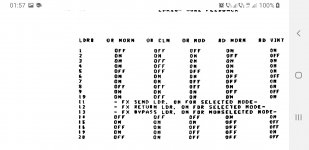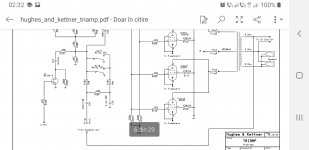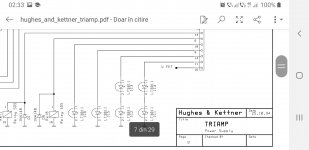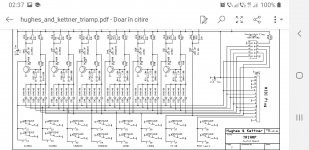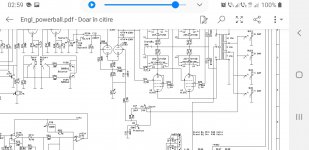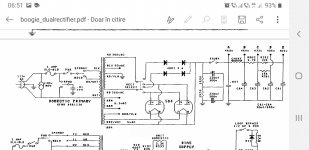Apparently electric guitar players tend to dislike anything that distorts either more or less than a slightly overdriven open loop valve amp.
I don't agree.
A good majority of those tube amps with revered "power amp distortion" do not have open loops; in fact, open loop power amps are actually a quite of niche and most are more or less AC30 copies with specific circuit topology characteristics.
A good majority of revered tube amps actually have preamp-based distortion circuitry (e.g. Mesa Boogie, Soldano, 5150, post JMP master volume Marshall amps, etc.) The distortion circuits of these come in wide variety, though surprisingly few actually make even slightest attempt to emulate distortion characteristics of tube power amps. You could consider some of these designs "open loop" (some Peavey and Dumble designs excluded for instance) and several of these designs employ at least degenerative cathode feedback.
In most cases distortion characteristics of these are anything but "sligthly overdriven".
And that's the challenge with that circuit - the impedance downstream depends on the tone settings. And I've not even tried to get my head around that...., but you need to look at the charge/discharge time constants through the LED1 and LED 2 (plus series resistance).
So I just sorted out C11 (as there's DC blockage further down stream) to get some asymmetry and will skip the bias shift. (Maybe there's something that can be done on a side chain - as you said, a little maths is required)
Not the Dual Rectifier!I don't agree.
A good majority of those tube amps with revered "power amp distortion" do not have open loops; in fact, open loop power amps are actually a quite of niche and most are more or less AC30 copies with specific circuit topology characteristics.
A good majority of revered tube amps actually have preamp-based distortion circuitry (e.g. Mesa Boogie,
In most cases distortion characteristics of these are anything but "sligthly overdriven".
Attachments
Same with Huges & Kettner Triamp soldano clone where only Clean, crunch 1 and crunch 2 is engaging the feedback relay: follow pin 6
Attachments
Similar feedback controll in Engl Powerball...You just reminded me what was that made the most sought for agressive drives in all these amps designed specifically for the kind of rock coined by John Petrucci...I never came to clone Engl, Diezel and Bogner as the schematics at the time(2007...2008) were hard to reverse engineer or find in a clear print, but I cloned almost all the famous amps and tones ...and the variety of tones obtained without feedback were very sought for by the dream theater guitar fans...
Attachments
Well, there's still good 2/3ths of them that are closed loop modes. Closed loop are also classic Marshalls like JTM45, 1959, 1987, 2204/2204, Silver Jubilee as well as Soldano, 5150, Dumble, Trainwreck, Jim Kelley, Mark series Mesa amps, etc.
Most Mesa open loop modes are really after weaker damping factors and resulting interaction with speaker impedance, not so much power amp overdrive characteristics. They have the distortion rather well covered in the preamp section.
I still firmly see majority of tube power amps as closed loop circuits and that extremely few tube-based preamp distortions try to emulate tube power amp distortion.
Most Mesa open loop modes are really after weaker damping factors and resulting interaction with speaker impedance, not so much power amp overdrive characteristics. They have the distortion rather well covered in the preamp section.
I still firmly see majority of tube power amps as closed loop circuits and that extremely few tube-based preamp distortions try to emulate tube power amp distortion.
It's not just the weaker damping which honestly is not that important in a guitar cabinet, it is also shaping frequency response removing higher frequencies, thus higher order harmonics too in the most agressive lead drive mods where you'd normally have too many high order harmonics. Mesa preamps like Triaxis are uding an internal 5 band eq to taylor it.They also moved that 5 band EQ inside Petrucci's signature headamps.
As long as you find the same no-feedback mod in all the orange and/or red lead channels of the most brutal amps, that is not by chance...
As long as you find the same no-feedback mod in all the orange and/or red lead channels of the most brutal amps, that is not by chance...
Negative feedback will actually reduce treble because low damping interacting with voice coil inductance results to quite a bit of treble boost. Higher damping, provided by negative feedback, levels the response to reactive speaker load. Thus with NFB there is less bass and treble boost at frequencies at which the (reactive) load impedance is high.
Red and Orange channels of the old Mesa Dual Rec series are BOTH very high gain channels and have nearly identical signal paths and gain ratios as far as "gain staging" goes. The amp is effectively a SLO clone with extra feature of turning the stiff Soldano-like mode (Orange) "spongier" by removing the feedback and optionally using a sagggier supply (Red); the latter pretty stupid feature for a master volume amp that primarily gets is distortion from the pre, the former more sensible since it gives a huge bass pump at resonant frequency and added brightness and aggressivity.
There is slight difference in tonestacks of the two modes and the Red mode has a preamp-based "cut" -type presence control because the one in NFB loop is disabled.
Red and Orange channels of the old Mesa Dual Rec series are BOTH very high gain channels and have nearly identical signal paths and gain ratios as far as "gain staging" goes. The amp is effectively a SLO clone with extra feature of turning the stiff Soldano-like mode (Orange) "spongier" by removing the feedback and optionally using a sagggier supply (Red); the latter pretty stupid feature for a master volume amp that primarily gets is distortion from the pre, the former more sensible since it gives a huge bass pump at resonant frequency and added brightness and aggressivity.
There is slight difference in tonestacks of the two modes and the Red mode has a preamp-based "cut" -type presence control because the one in NFB loop is disabled.
Last edited:
I don't agree.
A good majority of those tube amps with revered "power amp distortion" do not have open loops; in fact, open loop power amps are actually a quite of niche and most are more or less AC30 copies with specific circuit topology characteristics.
A good majority of revered tube amps actually have preamp-based distortion circuitry (e.g. Mesa Boogie, Soldano, 5150, post JMP master volume Marshall amps, etc.) The distortion circuits of these come in wide variety, though surprisingly few actually make even slightest attempt to emulate distortion characteristics of tube power amps. You could consider some of these designs "open loop" (some Peavey and Dumble designs excluded for instance) and several of these designs employ at least degenerative cathode feedback.
I don't know anything about electric guitar amplifiers, I'm just trying to get to understand them a bit by following this thread. I notice that when someone comes up with a soft-clipping circuit C, that usually either leads to comments like 'C behaves different than a valve amplifier, so it is no good' or 'C is very interesting, as it behaves similar to a valve amplifier'. Apparently immitating valve amplifiers is the design target.
So the power amplifier tends to be closed loop and the preamplifier part either open loop or closed loop with very little loop gain. I guess the supposed soft clipping then happens in the preamplifier part.
In most cases distortion characteristics of these are anything but "sligthly overdriven".
If they are grossly overdriven, that seems to contradict Gnobuddy's wish for soft clipping.
Last edited:
Negative feedback will actually reduce treble because low damping interacting with voice coil inductance results to quite a bit of treble boost. Higher damping, provided by negative feedback, levels the response to reactive speaker load. Thus with NFB there is less bass and treble boost at frequencies at which the (reactive) load impedance is high.
It depends on whether you use shunt or series feedback at the output. In one of the threads here, but I don't remember which, JMFahey stated he uses both in his solid-state guitar amplifiers.
There's a variety of distortion desires and needs from different guitarists (or even the same guitarist at different times). Perhaps (I say perhaps because it's often hard to know what guitarists really mean unless they can say in electrical/technical terms) "soft clipping" also means "on the edge of breakup" meaning at a signal level where clipping (by a vacuum tube) just starts and becomes clearly audibly noticeable.If they are grossly overdriven, that seems to contradict Gnobuddy's wish for soft clipping.
Then there's "hard clipping" which is achieved by a much higher signal level into the clipping circuit, and it doesn't matter so much whether the clipping circuit itself is "hard" or "soft."
Aaron Lanterman has made many Youtube videos covering analog circuits in general as well as musically related - music synthesizers, guitar amplifiers and effects, all from the circuits and an electrical/electronics perspective. These are all classes from courses he teaches at Georgia Tech.
I notice that when someone comes up with a soft-clipping circuit C, that usually either leads to comments like 'C behaves different than a valve amplifier, so it is no good' or 'C is very interesting, as it behaves similar to a valve amplifier'.
Yes, but we have been conditioned with such statements and nice drawings of supposed tube soft clipping. But look at what they are actually doing with an oscilloscope and the clipping actually isn't that soft at all. I can point out several semiconductor distortion circuits that clip softer than generic tube power amps or the common cathode gain stages of their preamps.
If we want to achieve a certain goal - be it "tube sound" or "soft clipping" - wouldn't it be good to start from the premises that are not falsified from the start?
Apparently immitating valve amplifiers is the design target.
Yes. Because there are great sounding tube guitar amps. I do feel though that often the common reasons to explain that great sound are erroneous. e.g. myths of even order harmonics and soft clipping should be busted by now.
In addition, tube (guitar) amps come in a myriad of different designs with different tones and characteristics. There is no conclusive definition for what makes up that "tube tone". Good tone is also highly subjective and dependent on application.
One who likes AC30 may not much appreciate a Powerball, for instance.
Yes, because in practice many tube amps themselves contradict it.If they are grossly overdriven, that seems to contradict Gnobuddy's wish for soft clipping.
I suppose you actually meant "current" or "voltage" (negative) feedback?It depends on whether you use shunt or series feedback at the output. ... JMFahey stated he uses both in his solid-state guitar amplifiers.
I'm aware of just single one guitar amp with current feedback (1980's mpdular Seymour Duncan copied the old Bogen hifi amp idea) all others use generic voltage feedback that increases damping factor by reducing output impedance.
If we look at solid-state (guitar) amplifiers instead then we more commonly see current feedback employed, which does the opposite in order to emulate tube amps, which even after applying NFB tend to feature rather high output impedance.
You know where the "dual rectifier " name comes in Mesa amps, don't you?I remember that you complained about DF in tube guitar amps without feedback...Yes, but we have been conditioned with such statements and nice drawings of supposed tube soft clipping.
One who likes AC30 may not much appreciate a Powerball, for instance.
Yes, because in practice many tube amps themselves contradict it.
Attachments
I suppose you actually meant "current" or "voltage" (negative) feedback?
Yes, according to their original definitions. The term current feedback has been redefined at least twice (+), so I thought it would be less equivocal to write series feedback at the output.
(+): It originally means series feedback at the output (which increases the output impedance and makes the output current less dependent on the load), but Ernst Nordholt uses it for shunt feedback at the input combined with series feedback at the output, and op-amp people use it for op-amps that by design have a low open-loop input impedance at their inverting inputs.
You know where the "dual rectifier " name comes in Mesa amps, don't you?
Well, it's obvious. What is less obvious is what tube rectifiers have to do with damping factor or with feedback loops (or lack of them) of the power amp section? Care to enlighten?
IME, at best a tube rectifier might introduce a bit more power supply voltage sag under heavy current draw, but that means one would have to first "load" them, which is a rare occurence in high power master volume amp devised to amplify the preamp signal cleanly with ample headroom.
I can understand the open loop mode, as it is a different EQ option for the "stiffer" distortion mode ripped off after Soldano and hot rodded Marshall 2203 in general. But it's just a different option, not the "best" and certainly not representative of what is "norm" for tube guitar amps.
Say, if Soldano was after this "soft clipping" and "open loop" operation then why did they devise a super high gain preamp with abrupt clipping characteristics that they amplify with high power, high headroom fairly transparent power amp "stiffened" by negative feedback and diode rectified power supply with ample filtering... just doesn't make sense. ;-)
Why did Silver Jubilee do essentially the same thing, not to mention why does it suppress preamp tube distortion with feedback loops and actually employ semiconductor diodes for clipping? Just doesn't make sense.
Or maybe it does. Maybe we don't always want super spongy tube amps with super soft clipping. Maybe not all amps need to be like AC30, maybe some amps are perfectly good when they are entirely different. Maybe these "tube tone" or "tube circuit" concepts are too vague to be filed under generalisations.
It seems to me that you had no contact with a mesa engineering type of guitar player.I did.In fact with two very good players using the same type of distortions that mesa does.
I only know that they preffered the no feedback arrangement by far considering it more "dynamic" or "ballsy".
The tubes rectifiers do make a difference and that sag is more pronounced in any of the tube rectifier connections where all voltages are lower and the tubes are in current mode with a fixed bias in the final stage.You can make yourself a clearer opinion on this just by listening to the difference.As you can see, the guy expresses the completely reversed expectations upon the output power in the Spongy vs Bold setting where actually the power should be higher in the Spongy mod and that's because the higher harmonic content in the Bold variation is actually giving the opposite feeling.
I personally preffer the Tube rectifier sound by far which is "Bold" er than any solid state rectifier setting...
I only know that they preffered the no feedback arrangement by far considering it more "dynamic" or "ballsy".
The tubes rectifiers do make a difference and that sag is more pronounced in any of the tube rectifier connections where all voltages are lower and the tubes are in current mode with a fixed bias in the final stage.You can make yourself a clearer opinion on this just by listening to the difference.As you can see, the guy expresses the completely reversed expectations upon the output power in the Spongy vs Bold setting where actually the power should be higher in the Spongy mod and that's because the higher harmonic content in the Bold variation is actually giving the opposite feeling.
I personally preffer the Tube rectifier sound by far which is "Bold" er than any solid state rectifier setting...
Last edited:
Meanwhile (meh-while*) back in the real world: have your cake and eat it too with Rob Robinette's Three way feedback switch.
*The idea that there's a single tube guitar amp "sound" that everyone is chasing is just a little naive. Even the so-called "perfect modellers" (and yes, I have a Flamma FS06 on order, thanks be to Gnobuddy) come with a suite of sounds. For a reason. And, usually, a suite of cabinet styles. (It'd be nice if we could also thrown in a mix of speaker drivers too.)
If you want "abrupt" find a stock Vox Pathfinder V15 and hit "boost". Fizz city from back-to-back diodes with little frequency shaping.
*The idea that there's a single tube guitar amp "sound" that everyone is chasing is just a little naive. Even the so-called "perfect modellers" (and yes, I have a Flamma FS06 on order, thanks be to Gnobuddy) come with a suite of sounds. For a reason. And, usually, a suite of cabinet styles. (It'd be nice if we could also thrown in a mix of speaker drivers too.)
If you're talking about the Superlead, then the descriptions out there (e.g. from AmpBooks or Rob Robinette) suggest it is anything but "abrupt", instead being shaped over four stages of amplification, mostly with different clipping characteristics. That is, two "standard" (if frequency shaping) gain stages, then a cold clipper, then a cathode follower stage. With order-of-clipping reversed.Say, if Soldano was after this "soft clipping" and "open loop" operation then why did they devise a super high gain preamp with abrupt clipping characteristics
If you want "abrupt" find a stock Vox Pathfinder V15 and hit "boost". Fizz city from back-to-back diodes with little frequency shaping.
- Home
- Live Sound
- Instruments and Amps
- Discussion: Unwanted clipping in solid-state e-guitar preamps
